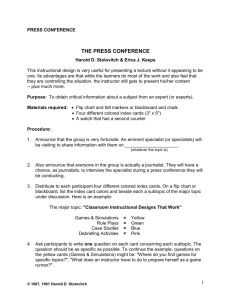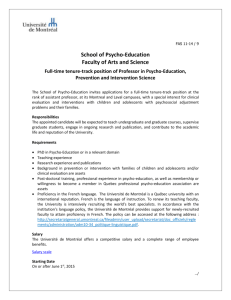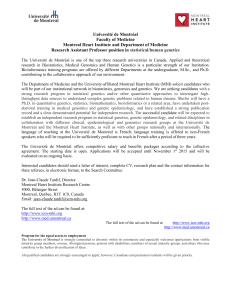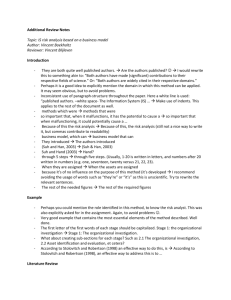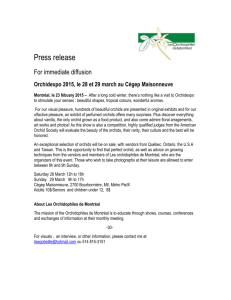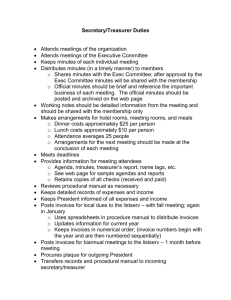Selecting and Writing Case Studies for Improving Human Performance
advertisement
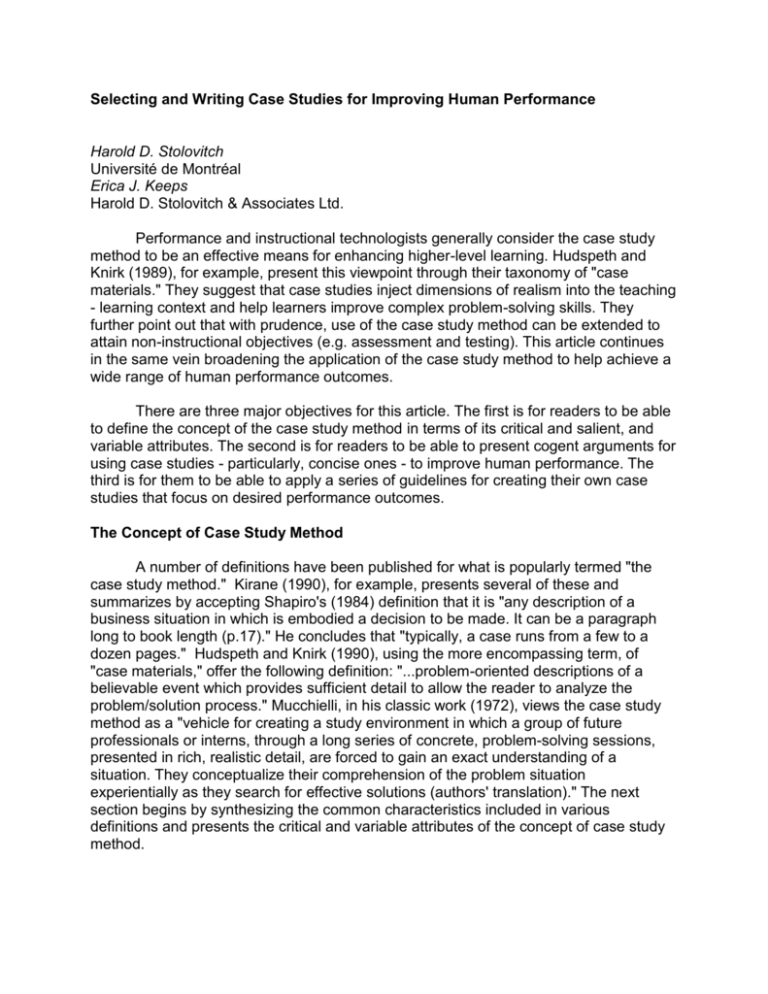
Selecting and Writing Case Studies for Improving Human Performance Harold D. Stolovitch Université de Montréal Erica J. Keeps Harold D. Stolovitch & Associates Ltd. Performance and instructional technologists generally consider the case study method to be an effective means for enhancing higher-level learning. Hudspeth and Knirk (1989), for example, present this viewpoint through their taxonomy of "case materials." They suggest that case studies inject dimensions of realism into the teaching - learning context and help learners improve complex problem-solving skills. They further point out that with prudence, use of the case study method can be extended to attain non-instructional objectives (e.g. assessment and testing). This article continues in the same vein broadening the application of the case study method to help achieve a wide range of human performance outcomes. There are three major objectives for this article. The first is for readers to be able to define the concept of the case study method in terms of its critical and salient, and variable attributes. The second is for readers to be able to present cogent arguments for using case studies - particularly, concise ones - to improve human performance. The third is for them to be able to apply a series of guidelines for creating their own case studies that focus on desired performance outcomes. The Concept of Case Study Method A number of definitions have been published for what is popularly termed "the case study method." Kirane (1990), for example, presents several of these and summarizes by accepting Shapiro's (1984) definition that it is "any description of a business situation in which is embodied a decision to be made. It can be a paragraph long to book length (p.17)." He concludes that "typically, a case runs from a few to a dozen pages." Hudspeth and Knirk (1990), using the more encompassing term, of "case materials," offer the following definition: "...problem-oriented descriptions of a believable event which provides sufficient detail to allow the reader to analyze the problem/solution process." Mucchielli, in his classic work (1972), views the case study method as a "vehicle for creating a study environment in which a group of future professionals or interns, through a long series of concrete, problem-solving sessions, presented in rich, realistic detail, are forced to gain an exact understanding of a situation. They conceptualize their comprehension of the problem situation experientially as they search for effective solutions (authors' translation)." The next section begins by synthesizing the common characteristics included in various definitions and presents the critical and variable attributes of the concept of case study method. All definitions of the case study method contain certain common elements. In general, they suggest that it is a form of simulation aimed at helping people to understand and deal with specific problems they might already encounter on the job or in some other life situation. Well designed case studies are composed of complete, accurate situation descriptions including events, people, and other relevant factors. They represent problems to be analyzed and solved. Critical Attributes The case study method contains the following essential characteristics: Form of simulation. A simulation is a dynamic and simplified representation of a system, based on a defined model (Sauvé, 1986). Simulations are not reality, but rather selected representations of their creators' vision. The case study is a subset of simulation in that it contains all its critical attributes (system, model, simplification, dynamism) plus the additional attributes described below. Clearly defined objective: analyze and solve job-related problems. Case studies have a specifically avowed purpose - to help learners and practicing professionals comprehend problems they actually or potentially may face on the job. Through participation in case studies, desired performance with respect to job-required problem analysis and solution may be attained. Contains complete descriptions. Each individual case to be analyzed and solved is self-contained. All necessary information, documentation, and other relevant material is included. Variations of the case study method exist in which participants must seek out additional information, but instructions for performing such activities are then embedded in the case itself. Contains accurate descriptions. Case studies require complete accuracy in their presentation. They may include occasional "red herrings" for specific reasons. However, the case is a microcosmic system that demands all relevant elements be present. Its purpose, after all, is to facilitate comprehension and solution based on realistic sets of data. Presents clear situations. Every case includes a situation containing all relevant events, characters, issues, factors and information that impact on it. Through study of the situation and all associated details, participants are expected to analyze and solve the case. Variable Attributes While all cases possess the critical attributes described above, they vary in a number of ways including the following more notable ones: Purpose. The case study method is primarily viewed as an instructional vehicle. However, cases may be used to attain other objectives such as testing (Stolovitch & Dupont, 1992), assessment and diagnosis (Stolovitch, Keeps & Okros, 1999), proficiency maintenance (Stolovitch, Keeps & Kerr, 1988), creative problem-solving (Mucchielli, 1972) and organizational development (Thiagarajan, 1980). Length. As pointed out by Shapiro (1984) and others, print-based cases can vary from a single paragraph to numerous pages. The specific purpose of the case and the context in which it is used as well as the capabilities of the target user group for which it is designed all affect length. Level of detail. The more technical the problem, the greater the level of detail. Cases dealing with financial decision-making may require considerable amounts of data. Cases focusing on ethical dilemmas may be presented in a few paragraphs. As a general rule, brevity and austerity in the presentation of details make for better case studies. Individual or group involvement. Cases may be designed for single users (e.g., Stolovitch, Keeps & Okros, 1990) or for entire groups, complete with facilitator (e.g. Mucchielli, 1972, Blondin, 1983). Type of conclusion. Cases may terminate with a textbook solution (there is only one or a limited number of "right" answers), some form of directed conclusion that allows participants to answer specific questions in a prescribed fashion or in an openended manner with no correct answer (e.g., a personal, moral or professional decision). Why Use Case Studies? The case study method, as stated previously, is a form of simulation. As such, it has demonstrated its ability to facilitate transfer of skills to operational settings (e.g., Sauvé, 1985; Renaud & Stolovitch, 1988). Through participation in case studies, individuals or groups develop skills in identifying, analyzing and solving problems. It marries theory to practice. When used with groups of learners or practitioners whose backgrounds vary, the case study method brings a variety of viewpoints to bear on a problem and consequently enriches the outcome. To illustrate, Stolovitch and Lane (1989) created a series of brief cases for bus drivers faced with a growing multicultural ridership. These cases were drawn from actual incident reports. Case Study 1 contains a sample, brief, bus driver case. Individual drivers read and attempt to solve the problem based on their own unique experiences. They then discuss the case in teams. Finally, the entire group discusses the case and resolves it based on the law, public transit policies and procedures and group consensus. Case Study 1. Sample Case Study for Public Transit Bus Drivers: Harassment A bus is travelling along Park Avenue at 2:30 p.m. on a hot summer afternoon. There are about 15 people on the bus. Everything is going smoothly, when suddenly, between stops, a woman passenger runs up the aisle shouting that someone is molesting her. The driver stops the bus and follows the woman back to her seat. She points to a middle-eastern looking man of about forty. She explains in an agitated, hostile manner that while there are plenty of seats on the bus, this man chose to sit down beside her. She explains that she had asked him politely to give her some room that he was sitting too closely. He had not responded. Another woman backs up the story of the distressed woman. The middle-aged man who is the subject of the commotion doesn't seem to understand what is going on. The driver questions him about the situation, but he receives no reply. The driver orders the offending passenger to change seats. When the passenger doesn't respond, the driver physically moves him to a seat far away from the other passengers. 1. Determine whether or not the driver made the right decision. Support your conclusion. 2. What would you do in the same situation? Explain why. The case study method also allows participants to: Ask (or ask themselves) questions that help extract key information. Through confrontation with the realities and complexities of a situation (e.g., an unusual loan request, an emergency evacuation, a sales decision) participants can learn to pose the right questions that lead to the acquisition of critical information. (e.g., What is it that I have to know about the person requesting the loan and where do I find this information? What are my priorities once the evacuation decision is made and how do I implement procedures without injuries to anyone, especially children? How do I quickly ensure that the customer qualifies for the sale so that I do not waste my time?) Diagnose actual cases. (Did the driver's actions conform to transit policies? Should he have left the wheel while passengers were on board?) Define all the different issues involved in the case. (Do I have sufficient data on the company requesting the loan in terms of capitalization, market potential, quality of management? What is the character of the person requesting the loan? What equity is involved? Who are my competitors for the loan?) Make decisions. (Given the toxicity of the chemicals involved in the spill, what precautions do I take for the workers involved? Which agencies do I contact first? Do I inform the media so that they can warn the public? What are the consequences of letting this get out to the public?) Formulate principles for handling future situations. (Which policies and procedures must we rigorously apply in similar circumstances and on which ones can we make judgment calls? What training must we implement immediately and maintain on an ongoing basis? Which "fatal flaws" tell me not to grant the loan, no matter how attractive the deal looks?) Relevance of the Case Study Method for Various Groups The relevance of the case study method depends upon two primary factors: (1) The backgrounds and characteristics of the targeted user group, the nature of the performance requirements. The case study method is particularly effective with groups that have had supervisory or management experience. Cases encapsulate numerous elements that require sorting and categorizing before effective analysis, diagnosis and solution decision-making can occur. The richness and complexity to which case studies lend themselves make them particularly relevant for higher-level processing and creative problem-solving generally associated with managerial responsibilities. Nevertheless, this method may also be used effectively with non-managerial personnel if the cases are brief or do not require knowledge of policy and decision-making processes. Cases that are directly tied to the job (e.g., care of patients, handling of customers, working in teams, processing of claims) can have direct and immediate impact on subsequent performance. This is especially true when the case study method is applied following training or integrated with on-the-job experience. In summary, the case study method offers opportunities for technical personnel, professional practitioners, managers, and learners of all sorts to acquire higher-level problem-solving and decision-making skills. By dealing with situations that actually existed in the past or that simulate potential occurrences, analytic, diagnostic and prescriptive competencies are practiced and honed. Guidelines for Creating a Case The case study method has been used as an instructional and business problemsolving vehicle since the beginning of the century (and in the military for many centuries). A number of books and articles, therefore, exist that explain how to create case studies of various kinds (e.g., Andrews, 1953; Culliton, 1946; Engle, 1973; Fraser, 1931; Kirane, 1990; Pigors & Pigors, 1980; Thiagarajan, 1980). What follows is a synthesis of these guidelines. The focus in the guidelines below is on shorter cases that can be applied in a wide variety of contexts. To help readers create solid, usable cases, the authors present three sets of information. The first includes a comparison of the consequences of well and poorly designed case studies. The second offers two principles to be applied to the general design of cases. The third lays out seven steps to follow for creating effective case studies. Good Cases... and Bad So many examples of case studies exist in so many different forms, that often any presentation of a set of facts surrounding an issue to be resolved appears to qualify as a "case." Well designed case studies result in the following consequences: Case users learn to focus on the essential attributes of a case. They are not distracted by inconsequential information. They analyze and solve case situations in a logical manner and are thus able to transfer and generalize case outcomes to their own settings. Case users are enriched by the experience of working with the case studies. As they progress through the materials, they gain insight into the issues being dealt with. The process of diagnosis and resolution required by well-designed case studies enhances understanding and skills for dealing with future similar situations. Even in their divergence, solutions for well-designed cases fall within relatively narrow and predictable limits. This permits case users to link their conclusions directly to key content within the case studies and results in the establishment of clear cause-effect relationships - one of the prime purposes for utilizing this vehicle. In contrast, the consequences of poorly designed cases are as follows: The acquisition of counterproductive behaviors caused by distracting or irrelevant material; Confusion resulting from non-essential information presented in a salient manner; A broad range of interpretations of the case study materials with the result that the value of these cases becomes lost and the exercise of working through them, meaningless. Two Principles for Creating a Case For a case to be effective, two principles should be applied: 1. Each case should focus on a single issue. The purpose of a case is to help its users analyze and problem-solve based on a specified body of information. It is not a replacement for the real world, only a means for preparing to deal with it (or when employed in testing and assessment, demonstrate ability to handle a certain type of issue). The more issues at stake in a case, the greater the risk of confusion and confounding. Most guidebooks on case study method suggest exposing users to a series of single issue cases that build skills over time. Every case, therefore, should center on a minimum number of learning or performance issues to ensure that the central message comes through clearly each time. 2. A case must contain all the data necessary to arrive at a solution. All the facts and events that make up the case must be given. The feelings, habits, attitudes and expectations of key characters must be clearly articulated. The setting, if relevant, must be accurately described including time, place, and physical and social environment. Omission of required elements can result in incomplete or inaccurate case analysis. This, in turn, may lead to frustration and counterproductive outcomes. Some variations of the case study method are deliberately incomplete, requiring users to access other sources of information. These must then be specified (e.g., certain statutes, regulations, annual reports, specific artifacts) which represents another form of completeness. Steps in Creating a Case The following seven major steps summarize what the authors have found works best in creating cases for attaining desired performance outcomes: 1. Select a single specific topic, problem or issue. This selection must illustrate one or several clearly defined principles. The selection constitutes the heart of the case and thus influences all its parts including how it is represented. To illustrate, Case Study 2 presents a brief sample case, deliberately kept concise and focused on a single issue. It is one of a series of cases used to help retail managers improve personnel management behaviors. Case Study 2. Sample Case: Managing Tardiness Cheryl's coffee was getting cold. She was so engrossed in figuring out what to do about Dave that she didn't even notice. "Darn, Dave's late for work again! I know he's one of my best order-takers, but I've got to do something about his tardiness. Everybody really likes him - including me. He's got such a great personality that he just seems to get by being late. How do you get mad at Dave? "I've joked several times with Dave in the past about his being late and I know some of the others have kidded him about it, too. He's taken all the ribbing like a good sport, but it hasn't changed his behaviors much. I guess one of the problems is that his being late isn't really all that bad, because he always gets his work done. His orders are always perfect. But, it's beginning to affect the rest of the order takers. It's to the point that when someone else comes in late and I say something, they get really insulted and make scenes. "Look at Dave's time log. He's been late three times in a row and five times this month. It's just out of hand. I've got to do something!" Determine the exact nature of the problem. Determine what the possible causes are for the persistent tardiness. How can you verify these? Decide what policies and procedures are required to handle such circumstances and how these should be applied. What course of action should Cheryl follow with Dave? With others? 2. Collect relevant documentation to make your case "authentic." Sources for creating authenticity include: needs analyses interviews with management, employees or clients accident, absences, committee or turnover reports oral and written communications journal articles, books, films or newspaper clippings. The materials can either be woven right into the story of the case or appended to it as artifacts (e.g., a series of memos, time sheets, personnel records, disciplinary reports, interview reports). The accumulated materials should form the basis of a completely believable case for which rational solutions can be achieved. 3. Create an outline of the case. Select facts and incidents that will be easily recognized and understood by case study users. Organize these in a logical sequence. Remove any inflated or exaggerated components that might diminish the authenticity of the case. 4. Identify the characters. Limit the case to one or two main characters. Include two to four more characters as needed, but watch out for confusion. Clearly identify each character in terms of his or her position. In very brief cases, do not necessarily include names. If you do, avoid "cute" (e.g., Fred Fixum, the mechanic), "funny" (e.g. Gertrude Glutz) or "stereotypic" (e.g., Ebenezer Grasper, the boss) names. 5. Write up the case. Whether the case is long or short, present a clear, concise, coherent portrait (of the characters, events and information. Use a writing style that is simple, direct - no digressions - that speaks right to the reader. Occasionally include brief dialogues to create interest and allow readers to hear what the characters in the case have to say for themselves. In the case introduction, present the key characters early and provide information that clearly identifies them. Establish the relationship between the characters and the problem or issue under study. Include the organizational or social context. Recount events or incidents in chronological order. Occasionally, use flashbacks to fill in gaps or heighten the sense of realism of the case. In certain cases, you may have events overlap, occur simultaneously or repeat themselves. In the concluding sentence or paragraph or in directions following the case, point out the need for some form of action: a decision, a solution, a weighing of alternatives or a combination of these. Case Study 3 presents a brief case drawn from a morals and ethics course (Blondin, 1983) that exemplifies many of the writing suggestions listed above. Case Study 3. Sample Case: The Story of a Young Woman A young woman, neglected by a husband who spends his time engrossed in his work, allows herself to be seduced. While her husband is away on business, she goes to spend the night at her lover's home across the river. At dawn the next morning, she sets off to arrive home before her husband returns from his business trip. This means crossing back over the river. However, as she approaches the bridge, a wild, madman leaps out and threatens to kill her if she tries to cross. Terrified, she runs down to the shore to hail a ferryman and begs him to take her across in his boat. "Please, take me to the other side. I must get home and there's a madman on the bridge who has threatened to kill me if I try to cross!" "Only if you pay passage in advance," is his indifferent reply. She has no money. He refuses to transport her. Distraught, she now runs to her lover's home and asks him for the passage money. Without offering any reason, he replies "No!" Remembering that a bachelor friend who has always shown devotion to her lives close by, she knocks on his door to borrow the money. She recounts her adventure to him. His reaction is fierce and violent. He exclaims that he has long been in love with her. He is furious with her conduct and adamantly refuses to lend any assistance. In complete desperation, she decides that she has no choice but to attempt to cross the bridge. Alas, the madman, true to his word, slays her. Which of these six persons (in the order they are presented in the story: the young woman, the husband, the lover, the madman, the ferryman, the friend) should be held responsible for this death? Arrange the list in descending order of responsibility, justifying your decisions. N.B. From a legal point of view, none of the persons can be found guilty. 6. End with a bridge that leads from the case to user discussion. There are three usual types of conclusions that are frequently employed: Open-ended conclusion in which the case study users define the facts and problems. The sample in Case Study 3 is an example of this form of ending. Directed conclusion in which specific questions tasks or even a quiz follow the case. Closed conclusion in which a "textbook" solution is provided at the end of the case. 7. Select a title. Only when the case has been written should it be given a title. Selecting a title beforehand can lead to creation of a case that is more tied to the title than to the reason for writing it. Keep the title brief. Tie the title to a specific, essential element, idea or person that stands out in the case. Be careful not to imply a conclusion in the title (e.g., Never Give a Loan on Faith). Case Study Method Types and Formats Although cases can be created for almost any reason, four main types appear most appropriate for issues related to the improvement of human performance: The significant event case which describes an emergency, a problem that has come to a head or a festering situation that is about to explode. The series of events case that relates a sequence of incidents and occurrences over time surrounding an issue. The personal problem case in which an individual is faced with moral, ethical or personal decisions that have a direct impact on his or her future. The professional decision-making case in which a major decision of a professional, technical, or managerial nature must be made. Case formats vary widely. Some are condensed and presented in report form. Others may tell a story or describe a situation to which numerous artifacts such as spreadsheets, memos, and file entries are appended. Cases may also be designed in interactive form with presentation of information followed by questions and decisions to be made, followed by feedback, followed by more information in iterative fashion. No case, however, can (nor should) include every detail. A case represents a choice of items selected to recreate some aspect of reality. The choice of details should contribute to the best understanding of that reality. Length of cases should be a major consideration. Although length may vary depending on the nature of the issue, two factors govern how long the case should be: The capabilities of the targeted user-group (education, work experience, reading ability). The objectives of the case. What are the users supposed to gain? If one of their missions is to sort out relevant from irrelevant facts and materials, or if the issue is multi-faceted with many impacting factors, the case will naturally become longer. If, however, its purpose is to help make critical decisions based on well presented evidence, the case may only require a few paragraphs to be complete. As a general rule, the case writer should aim for brevity. Three double-spaced, typewritten pages constitutes a relatively long case for most performance outcomes. The longer the case, the more it is dependent on the reading abilities and memories of the users. Longer cases also take more time to process and analyze. Cases should be designed for efficiency as well as effectiveness in meeting performance objectives. Criteria for Evaluating the Quality of a Case Study The authors have studied, designed and applied case studies with highly diverse content, users and contexts. They have found the following criteria helpful in judging the quality of cases one either creates or selects for use from existing sources: Relevance of the case to the objective (performance requirement). The case leads users to perform in a manner consistent with desired outcomes. It is clearly related to the job. Authenticity of the case. It is realistic and presents the issue in a credible manner. The characters and events have face validity. The information is perceived as accurate. Urgency of the situation presented in the case study. It stimulates users to participate and seek immediate resolution. Completeness of the case. It forms a total system. Conclusion The case study method has demonstrated its utility for building learning and performance. Its effectiveness is dependent on the manner in which individual case studies are designed and applied. This article has provided readers with a set of attributes of the case study method, and a rationale for its use as a vehicle that goes beyond learning to the attainment of desired performance. It has provided guidelines for creating and evaluating case studies. The authors consider this method to be a valuable tool for both instruction and performance enhancement. If the article has achieved its purposes, readers should now possess a base for applying the case study method in their own work. References Andrews, K.R. (1953). The case study method of teaching human relations and administration. Cambridge, Mass.: Harvard University Press. Blondin, D. (1983). Atelier sur la methode des cas. Montréal, QC: Université de Montréal, Services Pédagogiques. Culliton, J.W. (1946). Writing business cases. Boston, Mass.: Graduate School of Business Administration, Harvard University. Engle, H. M. (1973). Handbook of creative learning exercises. Houston, TX: Gulf. Fraser, C.E. (1931). The case method of instruction. New York, N.Y.: McGraw-Hill. Hudspeth, D. & Knirk, F.G. (1989). Case study materials: strategies for design and use. Performance Improvement Quarterly, 2(4), 30-41. Kirane,D. (1990). Four by four: The case method. Training & Development Journal, March, 44(2), 17-25. Mucchielli, R. (1972). La methode des cas: connaissance du problème et applications pratiques. Paris: Les éditions ESF. Pigors, P. & Pigors,F. (1980). The Pigors incident process of case study. Englewood Cliffs, N.J.: Educational Technology Publications. Renaud, L. & Stolovitch, H.D. (1988). The effects of simulation-games on safety attitudes and behaviors in five-year-olds. Simulations and Games, 19(3), 328-345. Sauvé, L. (1985). Simulation et transfert d'apprentissage: une étude sur les niveaux de fidelité pour le transfert d'apprentissage (doctoral dissertation), Université de Montréal. Sauvé, L. (1986). La simulation, un outil d'apprenstissage. La technologie éducative: développement humain et technologies. Québec, QC: La Télé Université du Québec. Shapiro, B.P. (1984). Hints for case teaching. Boston, Mass.: President and Fellows of Harvard. Stolovitch, H.D. & Dupont, D. (1992). Multicultural awareness training: The STCUM experience. Montréal, QC: Secretary of State, Government of Canada. Stolovitch, H.D. & Lane, M. (1989). Multicultural training: Designing for affective results. Performance & Instruction, 28(6), 10-15. Stolovitch, H.D., Keeps, E.J. & Kerr, R. H. (1989). "High Seas:" A performance maintenance game. Paper presented at the 27th conference of the National Society of Performance & Instruction, Denver, CO. Stolovitch, H.D., Keeps, E.J. & Okros, A. (in press). Northern adventure: A personnel selection game. Human Resource Development Quarterly. Thiagarajan, S. (1980). Protocol packages. Englewood Cliffs, N.J.: Educational Technology Publications. HAROLD D. STOLOVITCH is a professor of Instructional & Performance Technology at the Université de Montreal and President of HSA Consulting. He has authored over 100 books, chapters, and articles on various aspects of Instructional & Performance Technology. Dr. Stolovitch is a frequent consultant to business, government, and military organizations. ERICA J. KEEPS is Executive Vice-President of HSA Consulting. She has managed training functions for two major corporations. Erica Keeps has designed numerous performance systems for business and industry. She has been named Member-for-Life by two Instructional and Performance Technology Societies for her contributions to these fields.
